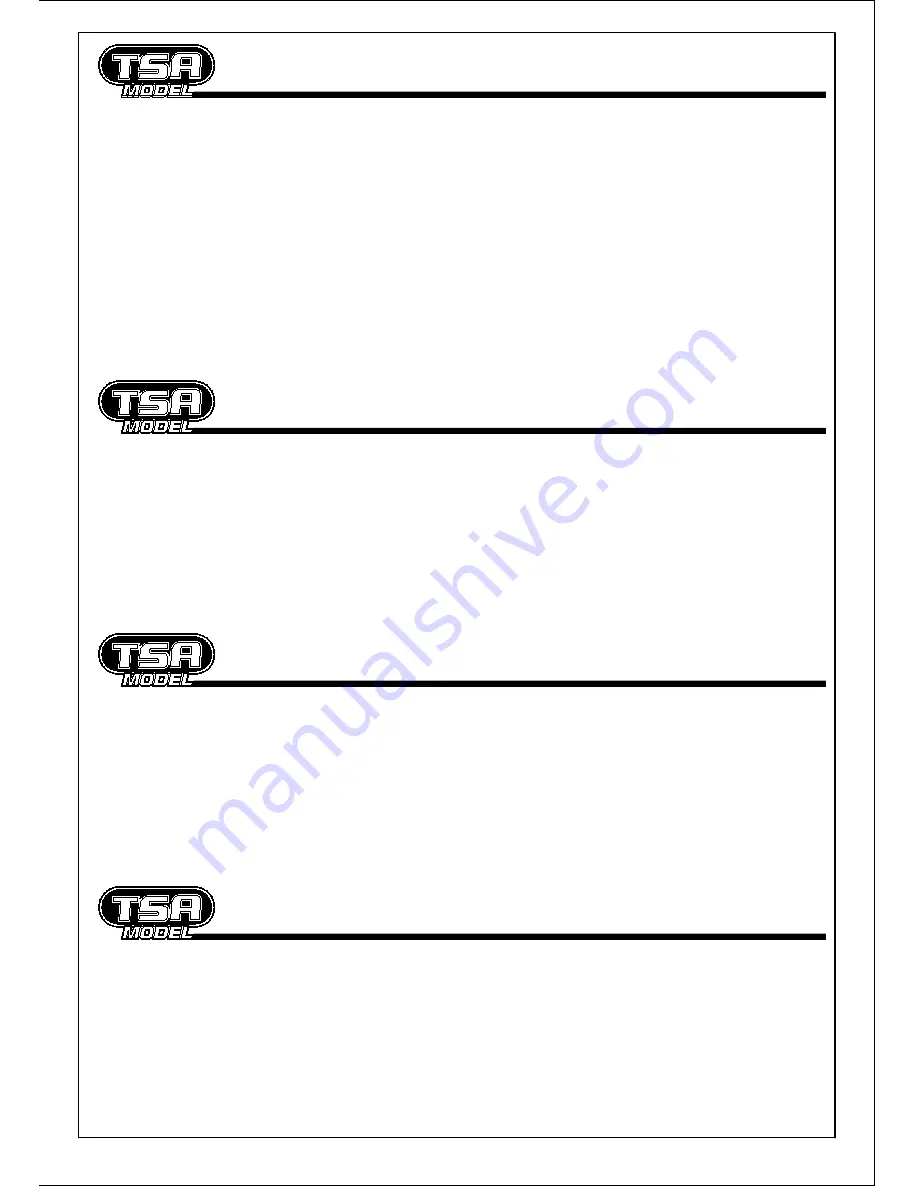
1
1: Beginners should obtain safety and technical guidance from an experienced individual, since learning alone to
operate this machine is potentially dangerous.
2: Choose a safe flying area that is free of obstruction and people.
3: Do not fly in a potentially dangerous environment.
4: Do not operate while standing on tilted ground to avoid loss of balance.
5: Do not insert hands and objects in rotating parts.
6: Keep a safe distance from the unit and be sure to operate the unit within the limits of your ability. Failure to operate
this unit properly may result in serious harm such as physical injury, damages to property, and even death.
7: Enjoy flying while observing safety rules and regulations. Fatigue brought upon by continuous operation may result
in impaired judgment that may lead to accidents.
8: Inquiries regarding repairs and services should only be made to TSA authorized dealers or TSA technical support
department. Individual lacking proper training or knowledge necessary for repair may not only impair the unit's
performance, but also increases the risk of accidents or injury. The engine must be turned off before performing any
repairs or adjustments. Repair damaged parts before storage using only TSA manufactured parts. When storing or
transporting the units, secure the unit carefully to avoid fuel loss, damage, or injury.
1: Check that tools used for assembly and maintenance has been put away.
2: Check that there are no loose screws and parts.
3: Check that the rotor blades are not damaged or cracked, especially in the vicinity of the blade holder.
4: Check the condition of the glow plugs and fuel, old glow plugs and fuel may not only cause difficulties to start the
engine, but also the possibility of stalling and crashing in mid-flight.
5: Check that electronic equipment and servos operates smoothly.
6: Check that the position of the transmitter's throttle stick and engine carburetor are at their low position.
7: Check that the receiver receives signals properly.
8: Check and ensure that all necessary parts are sufficiently lubricated.
9: Check radio is assigned to the correct mode.
1: When starting the engine, be sure to hold the rotor head firmly so the rotor head does not rotate.
2: Since the engine and muffler is heated from the operation and remains extremely hot immediately after startup or
shutdown, take extra precaution to prevent burns.
3: When taking off, the unit should be positioned at least 10 meters away from the operator. Be sure to check for people
and dangerous object in the surrounding area before takeoff.
4: Adjust the blade tracking right before takeoff.
5: Land the unit immediately if abnormal noise or vibration is observed. Then stop the engine and perform complete
check for cause of problem.
6: Be responsible when operating this unit, as reckless or improper behavior may cause accidents or injury to self or
others. Observe all safety rules and regulation while enjoy operating this unit safely and responsibly.
1: Only use glow fuel for glow model engines.
Glow fuel is highly flammable and should be handled with care.
2: Before refueling, the engine should be turned off.
3: Do not refuel near a naked flame. Do not smoke while refueling. Avoid spillage and be sure to always completely
wipe down any spilled fuel. Since fuel vapor and exhausted gas from the unit's operation are hazardous to health ,
this product is only intended to be used in an outdoor environment.
4: The fuel is hazardous. Do not consume and avoid getting fuel in the eyes. If an accident or swallowed occurs, obtain
professional medical advice/treatment immediately.
5: Fasten the cap on the fuel bottle tightly and store in a cool shaded place. Keep the fuel out of reach of children. The
ideal storage temperature should be around 10°C
.
While in flight
Fuel for engine
In-flight safety inspection
Pre-flight inspection
All manuals and user guides at all-guides.com
Содержание infusion 7000n
Страница 30: ...All manuals and user guides at all guides com...


















